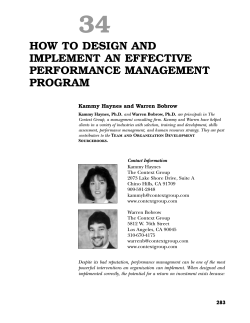
National Unified Goal Proposed For Traffic Incident Management Working Together for Improved
Proposed National Unified Goal For Traffic Incident Management Working Together for Improved Safety, Clearance and Communications What is Traffic Incident Management? Traffic Incident Management –TIM – refers to the Procedures and Practices used to respond to traffic incidents. TIM Programs are based on multidisciplinary Partnerships dedicated to implementing improved TIM Procedures and Practices. What is the National Unified Goal Traffic Incident Management? The Traffic Incident Management National Unified GOAL is: Responder Safety; Safe, Quick Clearance; and Prompt, Reliable, Interoperable Communications. How Will We Achieve the National Unified Goal ? NTIMC will achieve the three major objectives of the National Unified Goal by implementing 18 strategies. Some of the major strategies include: Recommended practices for multidisciplinary TIM operations and communications; Multidisciplinary TIM training; Goals for performance and progress; Promotion of beneficial technologies; and Partnerships to promote driver awareness. NUG Objective 1 Responder Safety Responder deaths and injuries are an increasing concern. >300 law enforcement officers die in vehicle incidents each year. >20% annual firefighter deaths occur on roadways. 5 towing industry struck-by deaths in first 3 months of 2006. NUG Objective 1 Responder Safety NUG Strategies for promoting Responder Safety are: Recommended Practices for Responder Safety; Move Over / Slow Down Laws; and Driver Training and Awareness. NUG Objective 2 Safe, Quick Clearance Non-recurring traffic incidents account for onefourth of congestion and delay. 1 minute of Interstate lane blockage = 4 minutes of delay. TIM promotes quicker clearance, but not at the expense of responder safety, or of achievement of the missions of all responders. NUG Objective 2 Safe, Quick Clearance NUG Strategies for promoting Safe, Quick Clearance are: Multidisciplinary TIM Procedures; Response and Clearance Time Goals; and 24 / 7 Availability. NUG Objective 3 Prompt, Reliable, Interoperable Communications Improving incident communications is essential to achieving other goals. Because incident communications is both important and complex, it is highlighted as the third NUG objective. NUG Objective 3 Prompt, Reliable, Interoperable Communications NUG Strategies for promoting Prompt, Reliable, Interoperable Communications are: Multidisciplinary Communications Practices and Protocols Prompt, Reliable Responder Notification Interoperable Voice and Data Networks Broadband Emergency Communications Systems Prompt, Reliable Traveler Information Systems Partnerships with News Media and Information Providers 6 NUG Cross-Cutting Strategies 6 NUG Strategies are cross-cutting. These strategies are the foundation for achieving all 3 major objectives of the NUG. TIM Parterships and Programs Multidisciplinary NIMS and TIM Training Goals for Performance and Progress TIM Technology Effective TIM Policies Awareness and Education Partnerships NTIMC Member Organizations Transportation (AASHTO, ATA/ATRI, ATSSA, FHWA, ITE, ITSA, I-95 CC, TRB, AMPO) Fire & Rescue (Emergency Responder Safety Institute, IAFC, IAFF, IFSTA, NFPA, NVFC, USFA) Emergency Medical Services (NASEMSO) Public Safety Communications (APCO, NENA) Towing & Recovery (TRAA, AAA) Law Enforcement (IACP) NUG Development Process Listening (Summer-Fall 2006) Consensus Development Conference, Nov. 28-29, 2006, Newport Beach, CA Incorporation of Conference Input (Steering Committee) NTIMC Release of Proposed NUG (March 1, 2007) Official ratification by Coalition Member Organizations (Spring-Summer 2007) Release of Final NUG at Joint Press Event (Fall 2007) FOR MORE INFORMATION NTIMC Web Site http://timcoalition.org Proposed NUG Proposed NUG Detail NUG Technical Papers Karen Haas editorsink@starpower.net
© Copyright 2025










